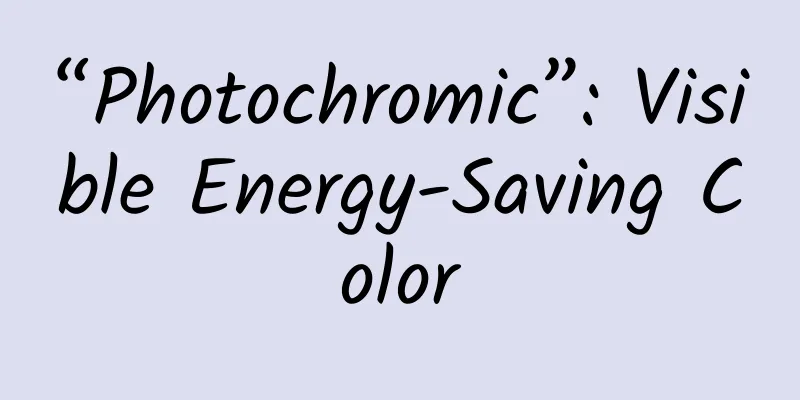“Photochromic”: Visible Energy-Saving Color

|
Energy conservation and emission reduction are currently important means to address global climate change. In 2021, building energy consumption accounted for 34% of global energy consumption, and building energy consumption accounted for 37% of carbon dioxide emissions. More than half of building energy consumption is used for cooling, heating and lighting of indoor spaces. In order to improve the energy efficiency of buildings, smart windows that can dynamically adjust the transmittance of sunlight have attracted much attention in recent years. The principle of this smart window is photochromism, which can adjust the color in time according to the light from different directions and adaptively control the sunlight. Recently, the team led by Academician Jiang Lei from the Institute of Physics and Chemistry of the Chinese Academy of Sciences published the research results of photochromic polymer film in Advanced Materials. The film can improve indoor daylight comfort, avoid excessive brightness and glare when the sunlight is strong, and will not affect indoor lighting when the sunlight is weak. As research on photochromic materials progresses, some smartphones use new and unique photochromic processing technology that combines inorganic photochromic materials with other materials to change color when exposed to sunlight. Photochromic glasses are no exception, changing the color of the lenses according to the photochromic principle to protect the eyes from strong light. Photochromic materials are considered to be materials that can gradually form two different states in terms of color, polarity, chemical composition, fluorescence emission, etc. This property can be applied to anti-counterfeiting labels, electronic components, photochemical engraving, photosensitive indoor and outdoor wall surface decoration and other fields. Organic photochromic materials were the first to be discovered in the development of photochromism. They have many varieties, rich light colors, and excellent plasticity. The most common ones are spiropyrans, spirooxazines, azobenzenes, diarylethenes, viologens, Schiff bases, etc. Compared with organic photochromic materials, inorganic photochromic materials have better high temperature resistance and fatigue resistance. Its color change principle is that under the irradiation of light of different special wavelengths, the electrons in the anisotropy produce charge transfer and transition, and the color changes on a macro scale. When the prepared material is irradiated by light of different wavelengths or gradually formed heat stimulation, it can be restored to its original form. In this process, some acid ions that act as important components or harmful impurities capture the electrons released in the light, which is the premise of electron transfer. The most common inorganic photochromic materials can generally be divided into transition metal oxides, polyoxometalates, metal halides and rare earth complexes. Organic-inorganic composite photochromic materials are obtained by hybridizing organic compounds with mineral elements. The final product has both the good modification effect of organic photochromic materials and the stability of inorganic photochromic materials. This new material obtains a large molecular framework with the help of ligand coordination, and the performance is determined by the original composition. Chemists will combine relevant functional groups, such as cathode polarization or light irradiation, to fully penetrate into the interior of monomers or oligomers to obtain customized organic compounds with large relative molecular weight. Organic-inorganic composite photochromic materials not only retain their respective physical and chemical properties, but also allow synergistic or antagonistic performance between modules. Photochromic materials are widely used in anti-counterfeiting identification. Anti-counterfeiting marks can be prepared through photochromic technology, and can be made into fibers and coated on the surface. Achievements have also been made in the storage of information related to optical images. With the help of the reversible input of color differences of photochromic materials and the specific data of information storage, the elements to judge the quality of stored information files are fast feedback, high luminous contrast, and three-dimensional data preservation. This type of optical material storage has obvious advantages such as fast response speed, high storage information density, and smooth operation, and its overall performance exceeds that of most storage devices on the market. Civilian functional fabric photochromic materials are combined with ordinary textiles, so that the functional fabrics used by people can show real-time color signals according to factors such as light and ambient temperature. In-depth exploration of the photochromic mechanism, scientifically explaining the color change process of photochromic materials, and developing new photochromic materials with better performance, lower cost, and more outstanding application effects are a major development trend of photochromic materials in the future. (Mo Zunli is a professor and doctoral supervisor at Northwest Normal University, and Chen Qianglong is a master's student at Northwest Normal University) |
<<: The secret the barber shop won’t tell you: Why does dyed hair always turn yellow in the end?
>>: The "flying dragon" in the sky is not a simple chicken
Recommend
Want to get rid of odor? Garlic lovers may try drinking yogurt
Science and Technology Daily, Beijing, September ...
Ampicillin Capsules
Ampicillin capsules are a very common medicine in...
Wild boars are on the scene, minnows are back, black storks are staying here… Where are Beijing’s wild animal “neighbors”?
Not long ago, a wild boar broke into a residentia...
The top ten evolutionary "weirdos" in nature, each one more outrageous than the other (Part 2)
Ailsa Harvey Walking fish The gills of the Mexica...
Does being able to remember yesterday’s dreams mean you slept well? That’s not necessarily true!
Tuchong Creative Do you still remember the dream ...
Fun fact: What other uses do pigs have besides providing meat for humans?
Pigs are the most common livestock among all live...
The efficacy and function of yellow flower purple salvia miltiorrhiza
Chinese medicine has different effects on our bod...
The efficacy and function of the wound grass
The small shangli grass is also called fairy peac...
Trivia | He Shen actually has the same surname as Zhen Huan, not He!
He Shen's surname was not He, but Niu Hulu. T...
Can angelica be soaked in water and drunk?
Drinking water is something we must do every day,...
What are the medicinal values of Curculigo
Most people may not know about Curculigo. It is a...
Is it better to take maca before or after meals?
I believe everyone is now more familiar with the ...
What are the medicinal values of slugs?
I believe that in daily life many of our friends ...
The red signals on women's faces should not be ignored! Why do "menstrual acne" recur?
Menstruation will accompany women for most of the...
The efficacy and function of hollyhock flowers
The development of Western medicine has brought s...









